Group Dance Competition Begins
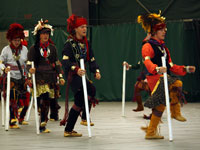 Combining equal parts choreography and teamwork, the group dance competitions require a different mindset than the individual dance competitions held on Sunday. Individual dancers work as part of a team to tell a story through dance instead of the more individualistic self-expression seen in the solo competition. Group dancing is more frequently associated with the southern area of the country. Other areas only have sacred/religious group dances that should not be publicly performed.
Combining equal parts choreography and teamwork, the group dance competitions require a different mindset than the individual dance competitions held on Sunday. Individual dancers work as part of a team to tell a story through dance instead of the more individualistic self-expression seen in the solo competition. Group dancing is more frequently associated with the southern area of the country. Other areas only have sacred/religious group dances that should not be publicly performed.
Eighteen dancers from Tsali Lodge in the Daniel Boone Council performed a sequence of dances from the Cherokee culture. While a narrator introduced the dance and the symbolic elements within it, dancers got into position. Their first dance was the Bar the Way dance, symbolizing Cherokee warriors preparing for the battle at Horseshoe Bend in 1814.
Each dancer carried a white wooden bar, representative of the heavy crossbars used to secure the front doors of their homes. Ironically, white is the Cherokee color for peace. The dancers were synchronized in their movements, banging their bars on the floor.
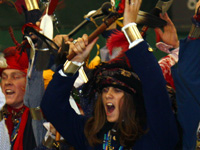 Following the Bar the Way dance, the dancers performed the Warrior Dance, symbolizing the warriors upon their return from battle. Some dancers wore navy blue coats, memorializing their brothers who died in battle.
Following the Bar the Way dance, the dancers performed the Warrior Dance, symbolizing the warriors upon their return from battle. Some dancers wore navy blue coats, memorializing their brothers who died in battle.
Wilson S, a Tsali Lodge dancer, was attracted to these two dances because of "the intensity of the dance" and the great focus necessary to perform. He's spent four years performing with the team. Fellow dancer Luke B. was part of the team that won the group dance competition at the National Order of the Arrow Conference in 2006 and was back here defending that title.
Chairman Zach P. remarked that he thought the team "did as good as we've ever done" and was quite proud of the dancers who joined the team only two weeks ago. He personally got involved with the dance team after attending a Cherokee dancing training session at a lodge fellowship when he was a young Arrowman. He and the other dancers extend a special thanks to their adviser Bill and the other advisers who help the team.
Cody B. put their performance into perspective: "With our team and with NOAC, we don't just dance to compete. We dance to bring the Cherokee culture to people who weren't as familiar with it." And from his team's performance earlier today, they succeeded in that goal.
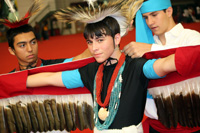 In contrast to the team from Tsali Lodge, the dancers from Colonneh Lodge performed the Eagle Dance at their first NOAC. Their last performance at NOAC was almost 20 years ago, so this was a monumental effort for them.
In contrast to the team from Tsali Lodge, the dancers from Colonneh Lodge performed the Eagle Dance at their first NOAC. Their last performance at NOAC was almost 20 years ago, so this was a monumental effort for them.
Joshua G. liked working with the "very tight group of dancers" from his lodge. They've grown close together since preparing a year for this particular performance. Other Arrowmen from the lodge performed the Eagle Dance at the 2005 National Jamboree and in local performances in the Houston area. The dance is traditional to the Houston area and has been passed down through members of the lodge.
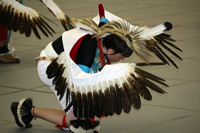 Joshua and the six other dancers wore costumes with eagle wings that they put together themselves. A group of women in the lodge offered significant help with the ribbons and beading. Altogether, it took about 16 months to build the outfits for the team.
Joshua and the six other dancers wore costumes with eagle wings that they put together themselves. A group of women in the lodge offered significant help with the ribbons and beading. Altogether, it took about 16 months to build the outfits for the team.
Dancers from Tsoiotsi Tsogalii Lodge with Old North State Council performed the Cherokee Quill Dance. Trey M, a singer and drummer with the team, said the team spent a lot of time researching the dance by reading and watching videos of past performances before starting their own practices.
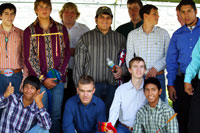 While the dance teams performed inside, singers and drummers competed without the dancers outside. Singers from Karankawa Lodge in the South Texas Council performed the Cozad Desert Storm Veterans Song. Written by the Cozad family singers in 1992, the song honors the Native Americans who fought in the Gulf War. To avoid stage fright during the competition, the team performs in front of friends and family first, to get over their nervousness.
While the dance teams performed inside, singers and drummers competed without the dancers outside. Singers from Karankawa Lodge in the South Texas Council performed the Cozad Desert Storm Veterans Song. Written by the Cozad family singers in 1992, the song honors the Native Americans who fought in the Gulf War. To avoid stage fright during the competition, the team performs in front of friends and family first, to get over their nervousness.
Revised 08/03/2009



